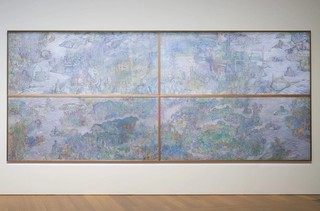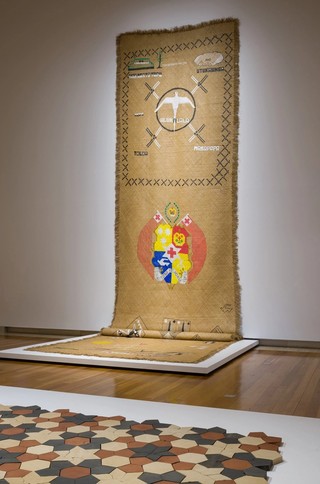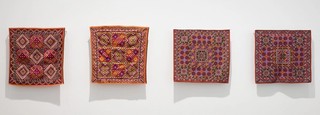Institutions need us

(l-r details) Kikik Kollektive Tul-an sang aton kamal-aman (Bones of our elders) 2024 / Subas Tamang KAAITEN: History, Memory, Identity 2024 / BOLOHO Lunar Factory 2024 / © The artists / View full image
Aniway Aquilizan reflects on their participation in the eleventh Asia Pacific Triennial. This is part one of a series that captures reflections from participants involved in ‘The 11th Asia Pacific Triennial of Contemporary Art’ Community Partner Program.
Tending fruits: Community reflection as resistance
Growing up as a Filipina settler on unceded lands means intimately seeing and feeling how colonisation operates. I moved to Australia from the Philippines when I was six years old and spent most of my early childhood at QAGOMA. My parents were both artworkers and artists there, so the State Library of Queensland and the Children’s Art Centre, Gallery of Modern Art were our playgrounds. I was fed and held by this cultural precinct. I grew up knowing the power of art and of public institutions in making people feel a sense of belonging.
My upbringing also meant that I had more access to the Gallery than other migrant kids of my generation. Though we persist anywhere and everywhere, I rarely caught whispers of Tagalog reverberating in the galleries. This isolation that I felt was the topic of so many artworks I grew up in communion with. Growing up alongside (and later working at) a public institution also made me understand them as sites of colonisation.
Institutions can shape collectives; collectives shape how institutions shift; and institutions can change. We know that institutions on unceded lands are formed under colonisation and genocide; we’ve discussed the normalisation of cultural extraction in this context on end in panels and symposiums. Despite increased awareness of what’s needed to make institutions more accessible and ‘culturally safe’, conversations about change are a false economy if not followed with meaningful action.
In working with Ruha Fifita (Curatorial Assistant, Pacific Art, QAGOMA) and witnessing her work within QAGOMA, I am reminded of the capacity for change-making within the boundaries of those white walls and polished concrete floors. There is always an opportunity to strengthen what institutions already have — an opportunity for them to work with us and for us. Dena Beard refers to the ‘radical work and radical pleasure’ possible in occupying these spaces;[1] this idea became the seed of our project in collaboration with House of Alexander, a Ballroom collective comprising Blak, Brown and Pasifika queer and trans artists living and working in Meanjin.
TAMBA artist Subas Tamang
Artists for Waiapu Action

AWA (Artists for Waiapu Action), Aotearoa New Zealand est. 2023 / He Uru Mānuka, He Uru Kānuka 2024, installation view ‘The 11th Asia Pacific Triennial of Contemporary Art’ 2024 / Courtesy: The artists, Radio Ngāti Porou and Te Amokura Productions / This project was assisted by Radio Ngāti Porou, Te Amokura Productions, Australia’s Mānuka, Just Thinking Out Loud, Museum of New Zealand Te Papa Tongerewa, Ngā Pae o Maramatanga (New Zealand’s Māori Centre of Research Excellence), Creative New Zealand, Te Wānanga Aronui o Tāmaki Makau Rau / AUT University, Waipapa Taumata Rau / University of Auckland, Te Wānanga o Aotearoa, Raukūmara Pae Maunga and The students of Ngata Memorial College / Photograph: N Umek © QAGOMA / View full image
Haus Yuriyal

Haus Yuriyal, (left to right) Kuman (shields) series 2024; Bopa series 2024; Kalabus (prison) series 2024; Kalabus (prison) series 2024; Kamkau Ike (Haus Toktok) 2024; Yuri Alai Eagles (Ceiling shield paintings) 2024; Garpa/Ground Paintings series 2023 installed during 'The 11th Asia Pacific Triennial of Contemporary Art' / © The artists and Milani Gallery,Meanjin/Brisbane / Photograph: C Callistemon © QAGOMA / View full image
Collectives and collective movements contributed a distinct richness and abundance to the Gallery’s eleventh Asia Pacific Triennial. TAMBA (illustrated), Paemanu Ngāi Thai Contemporary Visual Arts, Aunofo Havea Funaki and the Lepamahanga Women’s Group (illustrated), Artists for Waiapu Action (illustrated), Haus Yuriyal (illustrated), Kawaki and Dreamcast Theatre, Torba Weavers, CAMP, Boloho (illustrated), Kikik Kollektive (illustrated), Loupe, Australian International Islamic Colleges, Queensland Māori Society, the Pasifika Women’s Alliance, and the House of Alexander — all collectives selected to participate in this iteration of the Triennial have shaped the institution in return. There is a staunchness in the action of having these collectivities meet here, underscoring the need for alternative frameworks and models of care in artist–institution collaboration. In these contexts, we carve space for collective dreaming.
BOLOHO Lunar Factory 2024

BOLOHO, China, est. 2019 / Lunar Factory 2024 / Gel pen on paper / Four sheets: 107 x 240cm (each); 214 x 480cm (overall) / Commissioned for ‘The 11th Asia Pacific Triennial of Contemporary Art’/ Courtesy: The artists and Hanart TZ Gallery, Hong Kong / Photograph: C Callistemon © QAGOMA / View full image
As an example, the Triennial allowed me to cross paths with Kikik Kollektive. At my first encounter with the collective, a black beetle found my hand as its landing strip. We all read it as our ancestors smiling down on us. Kikik members Tin, Marrz, Marge and Noel cooked exotic iterations of food from home for my sister and I: kangaroo adobo, minudo cooked with tomato soup, and soto. It was comforting to exchange our diverse experiences of ‘Filipino-ness’ — understanding the Duterte drug war, disability support, food sovereignty and land rights in the Philippines from an experience of someone living there. Listening to our mother tongue inside the Gallery made me feel at home. Even more, as we connected in a world that can be unloving or isolating, we shared a song of lament.
Kikik Kollektive Tul-an sang aton kamal-aman (Bones of our elders) 2024
When Ruha and I first met with the House of Alexander, we were able to see weavings from across our homelands in QAGOMA’s gallery spaces: rattan from Papua New Guinea, grasses from across the Pacific and colourful cotton from Mindanao and the Sulu Archipelago. This experience comes with a deep feeling of being known and seen. Yet we were unable to touch these physical manifestations of our ancestors’ knowledge in the way that we know how. In our conversations with the Alexanders, we realised that the systems of an institution’s machine can be disjointed from human interaction; it begins to feel like our belongings are trapped in a glass cabinet, detached from the life that is imbued in them and their making — their essence.
‘Aunofo Havea Funaki Fala Kuta e Toa Ko Tavakefai‘ana 2024

‘Aunofo Havea Funaki, Tonga b.1972 / The Lepamahanga Women’s Group, Tongan people, Tonga est. 2016 / Fala Kuta e Toa Ko Tavakefai‘ana 2024 / Kutu culms (Eleocharis dulcis), lou‘akau (dried pandanus) / 1432 × 335cm (approx.) / Commissioned for ‘The 11th Asia Pacific Triennial of Contemporary Art’. Purchased 2024 with funds from the Oceania Women’s Fund through the Queensland QAGOMA Foundation / Collection: Queensland Art Gallery l Gallery of Modern Art / © ‘Aunofo Havea Funaki / Photograph: C Callistemon © QAGOMA / View full image
Our collaboration with the House of Alexander for the Triennial started 12 months ago. We wanted to co-create a series of reflection spaces with the collective through their connection to the exhibition series and beyond. Members of the House contributed to performances held for the previous Triennial, in 2022; they spoke of missing a moment for reflection with the institution before and after. There is a disjuncture when institutions have so much access to distinct arts communities, but communities do not have the same access to institutions.
In this ever-evolving project — part of the Community Partners Program — we’ve had the opportunity for ongoing conversation with the House and its members, underpinned by deep listening. We wanted to generate knowledge together that benefits artists first. The eleventh Triennial reminded us that dreaming together and making time to reflect deeply is a gift. It allows us to embody knowledge — to feel it in our limbs, in the touch of our fingertips and in the planting of the soles of our feet.
Conversations with artists, arts workers and visitors reinforce the need for institutions like QAGOMA to create access to this time and space. They can be our in-between places — where we exist not just to resist and be in protest. Especially for marginalised communities, institutions can open up to become sites where relationships of care can flourish and be nourished.
In part two, I share some of my reflections on the staunch role of House of Alexander and our time tending fruits at the Triennial. In this project, we understand that ballroom culture and the community that makes it is art and culture. All levels of the institution must sit in the discomfort of disruption to mundanity, as we normalise the existence of art not yet fathomable to institutions as art. It is the only way that we keep learning from collectives like the House. Having local artists and collectives like House of Alexander bless the Gallery floors is the key to this undertaking.
Mindanao and the Sulu Archipelago: Roots and Currents 2024

Mindanao and the Sulu Archipelago: Roots and Currents 2024 installed in ‘The 11th Asia Pacific Triennial of Contemporary Art’ 2024 / Photograph: C Callistemon © QAGOMA / View full image
Aniway Aquilizan, 'The 11th Asia Pacific Triennial of Contemporary Art' Community Partner
Aniway Aquilizan; Christine Ko and Louis Lim; Mohammed Azhari and Sara Shera, Australian International Islamic Colleges; Nina Taukiri, Queensland Māori Society; and Pasifika Women’s Alliance have been invited to work with QAGOMA to design and deliver a project with a specific segment of our Asian or Pacific communities. The aim is to investigate, co-design and actively foster meaningful connections and interactions between Triennial artists, audiences and local Asian and Pacific communities through a series of partner-led programs.
Asia Pacific Triennial
30 November 2024 – 27 April 2025
Queensland Art Gallery and Gallery of Modern Art (QAGOMA)
Brisbane, Australia
Free entry
Endnotes
- ^ Dana Beard, ‘Occupy Your Insitutions’, n+1, 30 July 2019, <https://www.nplusonemag.com/online-only/paper-monument/occupy-your-institutions/>, viewed March 2025

